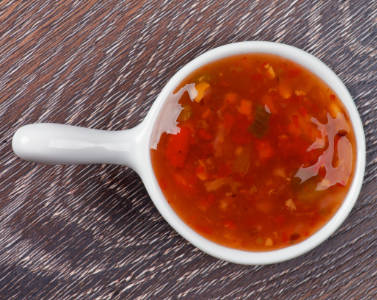Accompaniments Category

Includes condiments, pickles, and olives
sui kow wrappers
These are similar to potsticker wrappers, but they're intended to be used in soups. While assembling the dumplings, keep the stack of wrappers moist by covering them with a damp towel. Seal the dumplings with a "glue" made with cornstarch and water. Look for stacks of these wrappers in the refrigerator cases of Asian markets. Store them in the refrigerator or freezer, but let them come to room temperature before using.
Learn moresweet bean sauce
This brown sauce is made from sweetened fermented soybeans. Taiwanese cooks use it as a marinade or a condiment for meats.
Learn moretamari
Tamari is a type of soy sauce made only from soybeans, no wheat. It is less salty and thicker than traditional soy sauce. It is often gluten free.
Learn moreti leaves
South Pacific islanders use these to wrap food and to line the imu pits in which they roast pigs.
Learn moretomato paste
Tomato past is made by reducing tomatoes to a thick paste and filtering out the skins and seeds.
Learn moretomato sauce
Tomato sauce is thinner than tomato paste and tomato puree. In Australia what Americans call catsup is often called tomato sauce.
Learn moretomatoes canned
Canned tomatoes include whole peeled, diced or crushed. They usually contain seeds. They may need to be strained to remove the seeds and extra water.
Learn moretonkatsu sauce
This Japanese condiment is used to make yakisoba. Bull Dog is a popular brand.
Learn morewax paper
Invented by Thomas Edison, this is paper that's coated with paraffin wax to make it resistant to moisture. To use wax paper as a cake pan liner, place the pan on the paper, trace its outline, then cut it out and place it in the pan.
Learn morewonton wrappers
Wontons are the Chinese answer to ravioli--small packets of meat encased in a thin noodle wrapper. The wrappers are made of flour, eggs, and water, and, once filled with meat, can be easily folded and pinched into shape. While assembling the wontons, keep the stack of wrappers moist by covering them with a damp towel. You can seal the dumplings with a "glue" made with cornstarch and water. The wrappers come in different thicknesses. The thin ones work best in soups, while the thicker ones are best for frying. Look for stacks of them wrapped in plastic in the refrigerator cases of Asian markets. Store them in the refrigerator or freezer, but let them come to room temperature before using.
Learn moreWorcestershire sauce
Health foods sell a vegetarian version of this. To make your own: See the recipe for Worcestershire Sauce posted on RecipeSource.com.
Learn moreX.O. sauce
Asians pour this sauce over noodles and seafood. It's made from dried anchovies, shrimp, and chiles.
Learn more






























































































































































































































































































































































